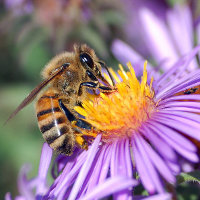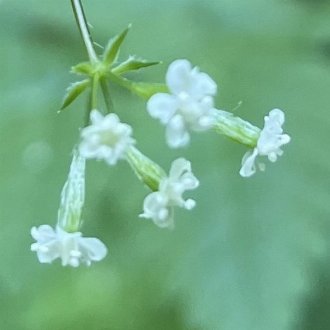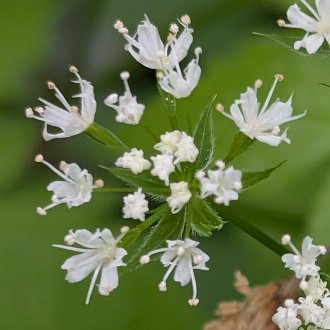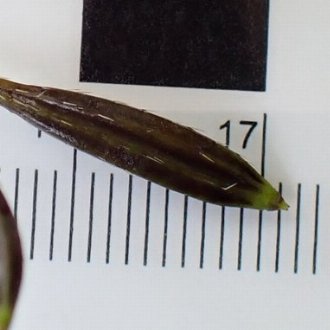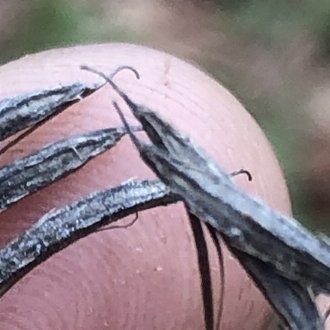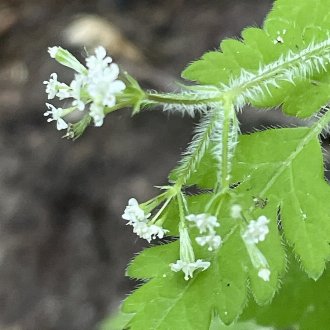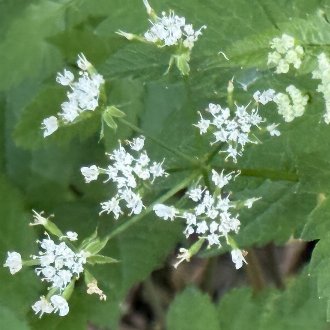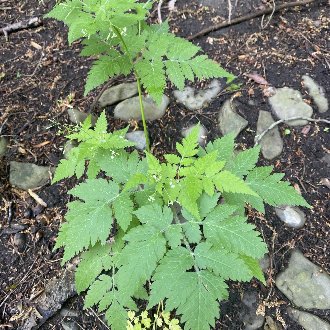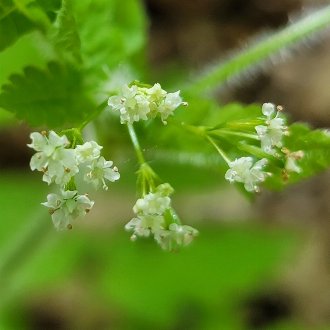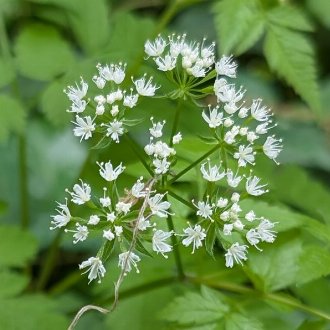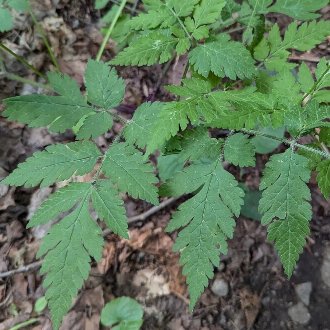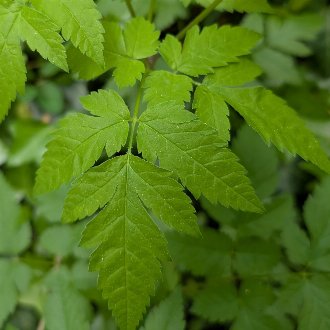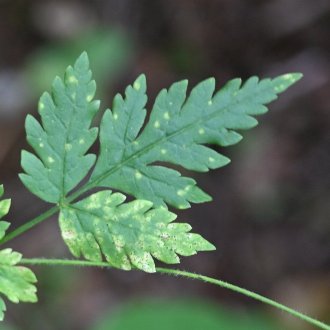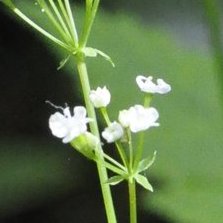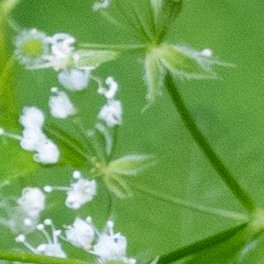Clayton's Sweetroot vs Aniseroot
These two species are visually similar, frequently occur together in the same habitat, and bloom at the same time. They can be told apart by examination of their flower clusters and seeds, and they have subtle differences in their leaves as well. O. claytonii ranges farther north, favors higher elevations, tolerates slightly drier sites and rockier soil, and is slightly more restricted to sites with good drainage, whereas O. longistylis ranges farther south and west, favors lower elevations, and is slightly more likely on moister sites.
Clayton's Sweetroot (Osmorhiza claytonii) | Aniseroot (Osmorhiza longistylis) |
A perennial native to rich, mesic woods in northeastern North America. | A perennial native to mesic deciduous woods in eastern to central North America. |
Umbellets (each cluster within the large flower cluster) usually have 4-7 flowers each, rarely as many as 10. Photo © Paula Dreeszen, CC BY 4.0. | Umbellets usually have 9-18 flowers per cluster, rarely as few as 6. Caution: additional flowers are mostly staminate flowers, which do not produce fruit. Count of fruit is more overlapping and less useful for ID. Photo © Kevin Anderson, CC BY 4.0. |
Tip of fruit has only short, stubby persistent styles. Photo © Steven Lamonde, CC BY 4.0. | Tip of fruit has long persistent styles. Photo © Andrew Conboy, CC BY 4.0. |
Umbels (total inflorescence) usually have 3-5 umbels (clusters of flowers) each, rarely as many as 6. Photo © Bob, CC BY 4.0. | Umbels usually have 4-6 umbels, rarely as many as 8. Photo © Matt Felperin, CC BY 4.0. |
Although habitat mostly overlaps, slightly more restricted to upland sites with good drainage, and slightly more tolerant of rocky soils. Photo © nebrooks, CC BY 4.0. | Although habitat mostly overlaps, ventures slightly farther into wet, poorly-drained habitats such as floodplains and swamps. Photo © Helen Johnson, CC BY 4.0. |
Umbels tend to be sparser and less showy, reflecting an average of fewer total flowers per umbellet, fewer umbellets, and slightly smaller flowers. Photo © Elias, CC BY 4.0. | Umbels tend to be denser and showier, reflecting an average of more flowers per umbellet, more umbellets, and slightly larger flowers. Photo © Kevin Anderson, CC BY 4.0. |
Foliage averages deeper-cut and more intricate, with a more fernlike appearance. Sinuses on leaflet margins cut deeper and reach closer to the leaflet's midrib. Leaves tend to be subdivided into more isolated pieces, with the pieces overlapping each other less. Photo © Benoit Renaud, CC BY 4.0. | Foliage averages fuller. Most sinuses on leaflet margins tend not to cut as deeply, with fewer of them reaching close to the leaflet's midrib. Leaf surfaces tend to be more fused, with fewer isolated pieces, with the pieces overlapping each other more. Photo © Kevin Anderson, CC BY 4.0. |
Leaflets tips are more likely to be acuminate, tapering to a long, narrow tip. Photo © Amber M. King, CC BY 4.0. | Leaflet tips are less likely to be acuminate, or tend not to be as pronouncedly so. Photo © Cole Wolf, CC BY 4.0. |
Bracts (leaflike structures) under each umbellet are usually smaller. Photo © Bruce Kirchoff, CC BY 4.0. | Bracts under each umbellet are usually larger. Photo © Bob Walker, CC BY 4.0. |
Additional Notes
Identification Notes
Some sources cite the amount of hair of the stem as a trait for telling these two apart, pointing to O. claytonii as being hairier than O. longistylis. We found this trait unreliable; for example, see this photo of O. claytonii, from TN, with a nearly-hairless stem, and this photo of O. longistylis from DC, with a very hairy stem. This trait may be reliable in certain localities, as certain local populations of one species or the other may have a narrower range of level of pubescence along the stem, but there is nearly complete overlap in these traits over the whole range. We also found an analysis by Ostertag and Jensen (1980) reinforcing that the pubescence is unreliable for ID.Although we found no keys and few sources citing differences in the foliage, and the foliage may be difficult to use alone for ID, we nonetheless noticed consistent differences in foliage between the two species. Even if the foliage is highly variable, it is useful to consult as a clue on plants where no flowers or seeds are present. Northwest wildflowers run by Adam Schneider notes both the tendency of O. claytonii to have deeper-lobed foliage, and also reports that the leaves of O. claytonii are more likely to be acuminate than O. longistylis.
Many sources cite differences in the aroma of these two species. Smell can be subjective and difficult to describe verbally, so we recommend smelling confirmed individuals of each species before trying to use this trait for ID. O. longistylis is usually described as having a relatively stronger scent of anise or licorice (note, however, that it may still be subtle, not as strong as anise or licorice itself, or other similarly-scented plants such as fennel.) O. claytonii on the other hand, is usually described as having either no anise/licorice scent whatsoever, or only a faint one, and FSUS also describes it as having a more carrot-like scent.
Habitat Notes
Most sources do not describe any difference in habitat preferences between these two species, and in their zone of overlap they are often found not only in the same habitats, but growing together side-by-side. However, there are some differences we found, as well as different tolerances that can be inferred through the differences in geographic distributions and associates.In their range of overlap, O. claytonii becomes more abundant at higher elevations, reflecting its adaptation to cooler climate conditions and the forest types that occur there, whereas O. longistylis becomes more abundant at lower elevations. O. longistylis is also slightly more likely to be found in flatter, wetter habitats. In the southeast, where soil pH is lower and forests tend to be more open, these habitats are restricted to the well-drained portions of floodplain forests of brownwater rivers, where waters bring more mineral-rich soils from upstream in the Piedmont. In the north and west of its range, however, it ranges into other moist, swampy forests, still usually being limited to locally better-drained sites within them.
These differences are consistent with the classifications of wetland status, with Plants of Pennsylvania marking O. longistylis as FACU but O. claytonii as FACU-, and the USDA marking O. longistylis as FAC for both the Great Plains and the Atlantic and Gulf Coastal Plain, whereas O. claytonii is marked FACU everywhere. U. Michigan's LSA Herbarium also reports O. longistylis in "moist (even swampy)" forests, contrasting with O. claytonii, and given that O. claytonii is more abundant overall in Michigan, the listing of a specific habitat for the less common species is notable. Although these differences are subtle, they are consistent throughout the range.
The pattern of ranging farther into bottomlands and wetlands is consistent with ranging farther west, as predominately-eastern species that inhabit bottomlands often range deeper into the great plains, due to increased moisture availability in bottomlands, than obligate upland species.
O. claytonii ranges farther into forests containing some conifers, although it is not common there, and is even more rare in pure coniferous forests. These conifers are typically more northern conifers found in the north of its range and at high elevations, not the southern pines found on drier sites at the south of its range and in low elevations; neither species overlaps much with the southern pines in habitat.
We suspect O. claytonii prefers (or at least tolerates) more acidic soil than O. longistylis, which we suspect prefers more neutral soil. This is consistent with the differences in elevation preferences within a region (as rain tends to wash Ca and Mg downhill, leading pH to increase going downhill), as well as O. claytonii's greater tolerance of conifers, which tend to drop acidic litter. Range clues are also consistent with this preference: O. longistylis ranges farther into the southeastern coastal plain only on floodplains of brownwater rivers, whereas it ranges much farther west into the great plains, and pH tends to increase moving west. However, we could not find information on whether these species are actually constrained by soil pH, or whether the effect is indirect, through driving structural changes in the ecosystem that in turn make better or worse habitat for each species.
Although we found no sources citing differences in shade-tolerance, and FSUS reports identical levels of heliophily (3) for both species, the forest types favored by O. claytonii include ones with highly shade-tolerant trees such as eastern hemlock (Tsuga canadensis) and sugar maple (Acer saccharum), which tend to cast denser overhead shade and lead to sparser understories. The habitats favored by O. longistylis, on the other hand, including swamps, floodplain forests, and more southerly forest types, have more open canopies but more ground-level competition. These differences suggest that O. claytonii may be more tolerant of overhead shade but less of ground-level competition, and vice-versa for O. longistylis. These observations are consistent with the tendency of O. longistylis to have a slightly more upright growth habit, an adaptation that helps with ground-level competition more than overhead shade.
References & External Resources
These short lists show only links helpful for ID. For a complete list of references and resources also covering other aspects of ecology, visit the links section of the full article on each plant, which is the first entry here.

